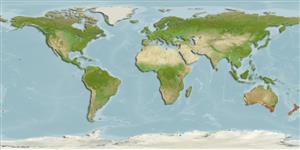Common names from other countries
分類 / Names
俗名 | 同種異名 | Catalog of Fishes(屬, 種) | ITIS | CoL | WoRMS | Cloffa
Teleostei >
Scombriformes (Mackerels)
鱸形目 (Mackerels) >
Arripidae (Australian salmon)
澳洲鮭鱸科 (Australian salmon)
Etymology: Arripis: Latin, arripio, arripere = to take something suddenly.
More on author: Forster.
Environment: milieu / climate zone / depth range / distribution range
生態學
海洋; 半鹹淡水; 溯河洄游 (Ref. 51243); 深度上下限 30 - 39 m (Ref. 58489). 亞熱帶的; 27°S - 47°S, 112°E - 176°W
Southwest Pacific: southern Australia (including Tasmania, Lord Howe Island and Norfolk Island), usually Brisbane to Western Victoria, rarely to Western Australia; and New Zealand (including Chatham and Kermadec Islands).
西南太平洋: 澳洲 (包括塔斯梅尼亞,羅得豪島與諾福克島) 南部, 通常對西方維多利亞的布理斯班, 很少地到澳洲西部; 而且紐西蘭 (包括 Chatham 與科瑪狄克群島).
Length at first maturity / 大小 / 重量 / 年齡
Maturity: Lm 32.5, range 29 - 36 cm
Max length : 89.0 cm TL 雄魚/尚未辨別雌雄; (Ref. 27296); common length : 47.0 cm TL 雄魚/尚未辨別雌雄; (Ref. 9258); 最大體重: 9.4 kg (Ref. 9988); 最大年齡: 26 年 (Ref. 9072)
背棘 (總數): 9; 背的軟條 (總數): 15-17; 臀棘 3; 臀鰭軟條: 9 - 10; 脊椎骨: 25. Adults are dark blue-green above and silvery below, with irregularly defined spots arranged laterally in indistinct rows (Ref. 33616). Length of upper lobe of caudal fin < 29.9% SL, more or less equal to, or less than, the length fo the head (Ref. 9701).
成魚是深藍綠色上方與下面銀色的, 在不明顯的列中有不規則的側面地被安排的清晰斑點.(參考文獻 33616) 尾鰭上葉的長度 <29.9% SL, 約略等於, 以內比較, 長度 fo 頭部.(參考文獻 9701)
Inhabit continental shelf waters including estuaries, bays and inlets (Ref. 6390). Found between depths of 30 m (Ref. 33616) and 39 m (Ref. 58489). They enter rivers (Ref. 9002). Juveniles form school in shallow coastal bays and estuaries; adults move in large schools along shores (Ref. 9002), and can move over reefs in depths just sufficient to cover their bodies (Ref. 6390). They form large surface aggregations in deep water (Ref. 6390). Feed mainly on fishes but also on pelagic crustaceans, especially krill (Nyctiphanes australis). Take also food from the seabed. Fish smaller than 10 cm feed predominantly on copepods (Ref. 9072). Utilized fresh, canned and frozen; can be steamed, fried, broiled, boiled, microwaved and baked (Ref. 9988).
棲息於大陸棚水域包括河口,灣內。 (參考文獻 6390) 發現在深度 30 公尺 (參考文獻 33616) 與 39 公尺之間.。 (參考文獻 58489) 他們進入河。 (參考文獻 9002) 稚魚在水淺的近岸海灣與河口形成魚群; 成魚移動大群魚群沿著海岸 (參考文獻 9002), 而且能移動正好充份覆蓋他們的身體的礁深度之上.(參考文獻 6390) 他們在深水中形成大的表面群集。 (參考文獻 6390) 主要捕食魚也捕食大洋性的甲殼動物, 尤其磷蝦 ( Nyctiphanes 南極光 ). 也帶食物從海底。 比 10 公分小的魚主要以橈腳類的動物為食。 (參考文獻 9072) 生鮮使用, 罐裝及冷凍; 能被蒸,油炸,火烤, 煮沸, 微波而且燒烤。 (參考文獻 9988)
Life cycle and mating behavior
成熟度 | 繁殖 | 產卵場 | 卵 | 孕卵數 | 仔魚
Eastern Australian salmon are probably serial batch spawners (Ref. 27961).西南太平洋: 澳洲 (包括塔斯梅尼亞,羅得豪島與諾福克島) 南部, 通常對西方維多利亞的布理斯班, 很少地到澳洲西部; 而且紐西蘭 (包括 Chatham 與科瑪狄克群島).
Paulin, C., 1993. Review of the Australian fish Family Arripididae (Percomorpha), with the description of a new species. Aust. J. Mar. Freshwat. Res. 44(3):459-471. (Ref. 9701)
CITES (Ref. 128078)
Not Evaluated
人類使用
漁業: 商業性; 游釣魚種: 是的; 誘餌: usually
更多資訊
合作者照片Stamps, Coins Misc.聲音神經毒速度泳型鰓區Otoliths腦重體重比眼睛色素
工具
特別的報告
下載 XML
網路資源
Estimates based on models
Preferred temperature (Ref.
115969): 15.6 - 22.3, mean 17.4 (based on 14 cells).
Phylogenetic diversity index (Ref.
82804): PD
50 = 0.6250 [Uniqueness, from 0.5 = low to 2.0 = high].
Bayesian length-weight: a=0.00955 (0.00352 - 0.02589), b=3.01 (2.79 - 3.23), in cm Total Length, based on LWR estimates for this (Sub)family-body shape (Ref.
93245).
營養階層 (Ref.
69278): 4.1 ±0.6 se; based on diet studies.
回復力 (Ref.
120179): 中等的, 族群倍增時間最少 1.4 - 4.4年 (K=0.2-0.3; tm=4).
Prior r = 0.47, 95% CL = 0.31 - 0.72, Based on 2 stock assessments.
Fishing Vulnerability (Ref.
59153): Moderate vulnerability (37 of 100).
Climate Vulnerability (Ref.
125649): Very high vulnerability (100 of 100).
